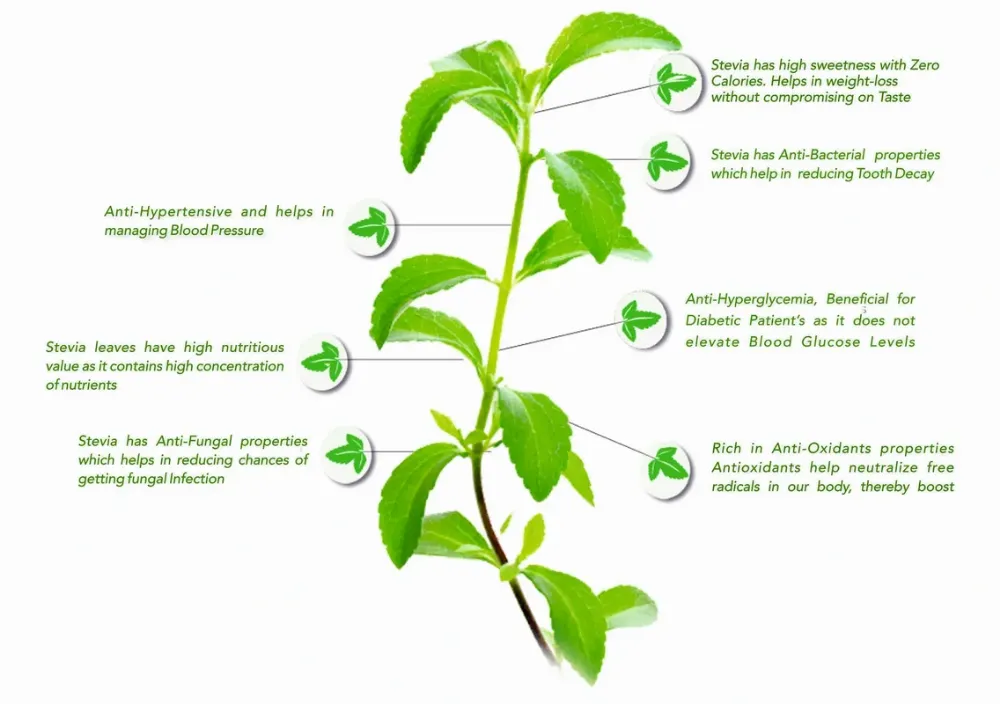About Stevia

ABOUT STEVIAStevia is a plant also known as Meethi Tulsi in India is god's gift... it is natural sugar free and it has been used as a sweetener (sugar replacement) for hundreds of years. Today, zero-calorie stevia, as high-purity stevia leaf extract, is being used globally to reduce energy and added sugar content in foods and beverages. HISTORY OF STEVIA PLANT Stevia is a natural substitute for sugar, it is zero-calorie sweetener that has been used as a natural sugar substitute and flavouring ingredient for many centuries. Native to South America, Stevia was first consumed their over few centuries ago when local people used leaves of the plant to sweeten beverages or chewed them for their sweet taste. The plant leaves, often called “sweet herb,” were dried and used to sweeten teas and medicines or simply chewed as a sweet treat.The stevia plant was first scientifically recorded in 1899 as Eupatorium rebaudianum by Moises Santiago de Bertoni, in Paraguay. In 1905, it was later defined as Stevia Rebaudiana, a member of the sunflower (Asteraceae) family.Stevia, as a plant extract, was first commercially adopted as a sweetener by Japan around 40 years ago, where it is still a popular ingredient today. Stevia is cultivated mostly in India, Paraguay, Kenya and the United States and within many other parts of the world, including Vietnam, Brazil, Argentina and Colombia. WHY NAME STEVIA Stevia is the generic term used to refer to different forms of the sweetener, including the whole plant Stevia (S rebaudiana Bertoni) and the leaves where the sweet compounds are found. The sweet-tasting components of stevia are called steviol glycosides, which are naturally present in the stevia leaf. There are 11 major steviol glycosides of which rebaudioside A and stevioside are the most abundant. Other examples of steviol glycosides are Stevioside, Rebaudioside A, B, C, D, E, F, Rubusoside etc . All these steviol glycosides vary in sweetness and bitterness.Only high-purity stevia extracts (95% purity or above) are approved by major regulatory agencies, including the Joint Food and Agriculture Organization/World Health Organization (WHO) Expert Committee on Food Additives and Codex Alimentarius (Codex) for use in foods and beverages. STEVIA ... A DIVINE PLANT Plant Stevia is a miracle of nature filled with sweetness which is 200 to 300 times more sweeter than sugar. Stevia can also be called sweeter sugar. Also popularly known as Meethi Tulsi, this small shrub, native to the Sunflower family, provides sweetness but has no caloric value. Stevia rebaudiana is a plant species in the genus Stevia of the sunflower family, Asteraceae. It is also commonly known as candyleaf, sweetleaf or sugarleaf. It is main ingredient of Stevia sugar free Sweetener or no sugar sweetener. STEVIA ... NOT ONLY NATURAL SWEETENER BUT MUCH MORE Stevia ( also called green sugar free ) is not only a sugar free sweetener but has many medicinal properties like anti-hyperglycaemia, anti-oxidative, anti-hypotensive, anti-cancer, antibacterial and antifungal (The Pharma Innovation Journal 2019; 8(1): 371-374). Stevia helps in Weight Loss, maintaining Blood Glucose Levels, Maintaining High Blood Pressure and also prevents tooth decay. It is 100% natural no sugar sweetener popularly called stevia sugar free which is not only free from side effects but also full of many health benefits. DIVINE LEAVES STEVIA POWDER TASTES JUST LIKE SUGAR The biggest problem with all Sugar Free Sweeteners is the bitter after taste but DIVINE LEAVES STEVIA 100% Natural Stevia Sugar Free Sweetener tastes just like Sugar without any aftertaste. This unique milestone has been achieved after years of research and passionate efforts of R & D team of DYAUSMED Healthcare. It is 100% Natural no sugar Sweetener which is 100% safe and does not have any side effects. Using stevia for sugar replacement is ideal solution for diabetics. |
STEVIA- AN INSIGHT






